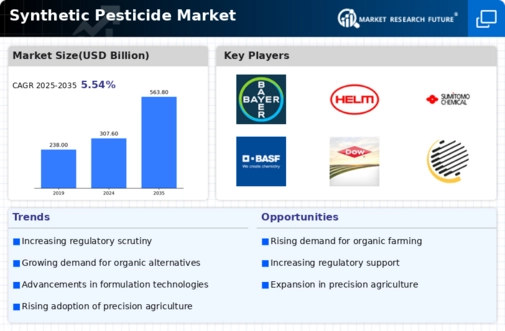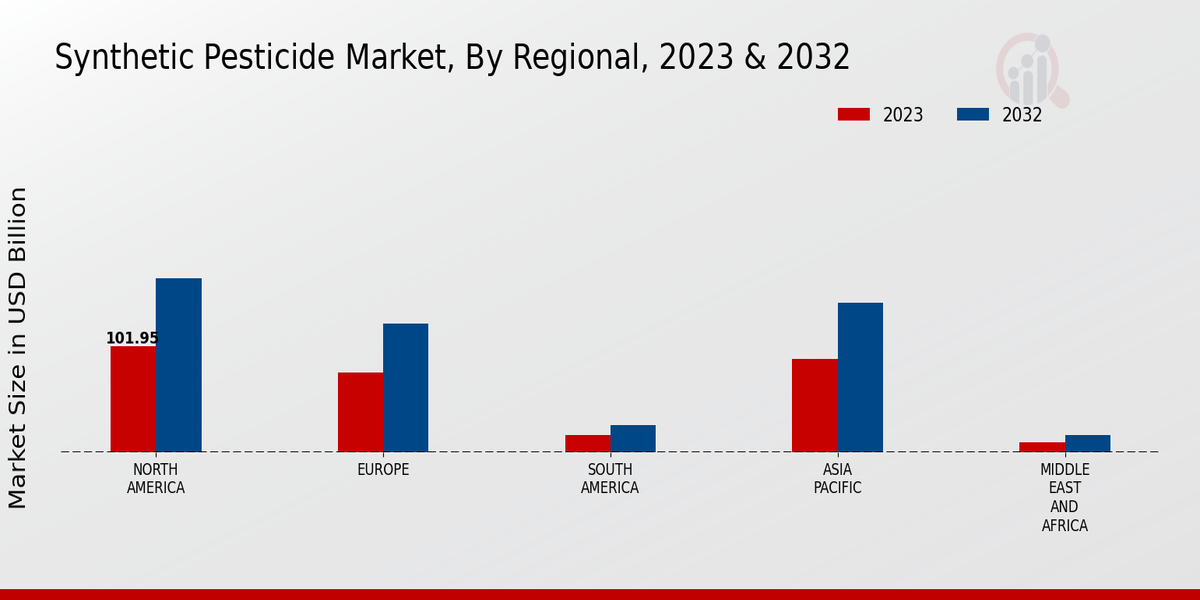Rising Global Population
The increasing global population is a primary driver of the Global Synthetic Pesticide Market Industry. As the world population is projected to reach approximately 9.7 billion by 2050, the demand for food production intensifies. This surge necessitates enhanced agricultural productivity, leading to a greater reliance on synthetic pesticides to protect crops from pests and diseases. In 2024, the market is valued at 307.6 USD Billion, reflecting the urgent need for effective pest management solutions. Farmers are likely to adopt advanced synthetic pesticides to ensure food security, thereby propelling market growth.
Increasing Pest Resistance
The rising incidence of pest resistance to conventional pesticides is driving the demand for synthetic alternatives within the Global Synthetic Pesticide Market Industry. As pests evolve and develop resistance, farmers are compelled to seek more effective synthetic solutions to manage these challenges. This phenomenon has led to the introduction of novel synthetic pesticides that target resistant pest populations, ensuring crop protection and yield stability. Consequently, the market is likely to expand as agricultural stakeholders invest in innovative pest management strategies to combat resistance issues.
Market Trends and Growth Projections
The Global Synthetic Pesticide Market Industry is poised for substantial growth, with projections indicating a market value of 563.8 USD Billion by 2035. This growth trajectory is underpinned by a compound annual growth rate of 5.66% from 2025 to 2035. The increasing demand for food security, coupled with advancements in agricultural technology and pest management strategies, suggests a robust market environment. As stakeholders adapt to evolving agricultural challenges, the synthetic pesticide market is likely to experience dynamic shifts, reflecting the ongoing need for effective pest control solutions.
Global Trade and Export Opportunities
The expansion of global trade and export opportunities is a significant factor influencing the Global Synthetic Pesticide Market Industry. As countries seek to enhance their agricultural exports, the demand for effective pest control solutions increases. Regions with strong agricultural sectors, such as North America and Europe, are likely to lead in synthetic pesticide consumption. This trend is further supported by international trade agreements that facilitate the movement of agricultural products and inputs. Consequently, the market is expected to benefit from increased cross-border trade, enhancing the availability of synthetic pesticides in various regions.
Technological Advancements in Agriculture
Technological innovations in agriculture are significantly influencing the Global Synthetic Pesticide Market Industry. The development of precision agriculture techniques, including drone technology and data analytics, allows for targeted pesticide application, reducing waste and environmental impact. These advancements not only enhance crop yields but also promote sustainable practices. As a result, the market is expected to grow at a CAGR of 5.66% from 2025 to 2035, reaching an estimated value of 563.8 USD Billion by 2035. This trend indicates a shift towards more efficient pesticide use, aligning with global sustainability goals.
Regulatory Support for Agricultural Chemicals
Regulatory frameworks that support the use of synthetic pesticides are crucial for the growth of the Global Synthetic Pesticide Market Industry. Governments worldwide are implementing policies that facilitate the registration and approval of new synthetic pesticides, ensuring that farmers have access to effective tools for pest management. This regulatory support is essential for maintaining agricultural productivity and food security. As the market continues to evolve, favorable regulations are likely to encourage research and development in synthetic pesticide formulations, further driving market expansion.




















